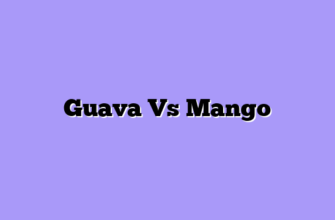Guava, a tropical fruit known for its sweet and tangy flavor, is enjoyed by many around the world. However, the presence of numerous seeds within the fruit can be a deterrent for some. While there are various methods to remove guava seeds, the scoop method stands out as a simple and efficient approach. This method involves using a spoon to carefully extract the seeds, leaving behind the juicy flesh.
The Scoop Method
To begin, select a ripe guava. A ripe guava will have a soft texture and a slightly fragrant aroma. Once you have chosen your fruit, wash it thoroughly under running water to remove any dirt or debris. Next, cut the guava in half lengthwise using a sharp knife. This will expose the seeds and flesh, making it easier to access them.
Now, take a spoon and gently scoop out the seeds from each half of the guava. The spoon’s curved shape allows you to navigate around the flesh, minimizing any unnecessary damage. As you scoop, be sure to remove the seeds as completely as possible. However, it is important to note that some seeds may remain embedded in the flesh. These can be easily removed later by simply picking them out with your fingers.

The scoop method offers several advantages over other seed removal techniques. Firstly, it is a quick and easy method that requires minimal effort. Secondly, it is a gentle approach that preserves the integrity of the guava flesh, ensuring that you get to enjoy the maximum amount of fruit. Lastly, it is a versatile method that can be used for both small and large guavas.
The Fork Technique
The first step in the fork technique is to select a ripe guava. A ripe guava will have a soft texture and a slightly yielding feel when gently pressed. Once a suitable guava is chosen, it should be washed thoroughly under running water to remove any dirt or debris. Next, using a sharp knife, carefully cut the guava in half lengthwise. This will expose the inner flesh and seeds.
Now, the fork comes into play. Holding the guava half firmly in one hand, insert the tines of the fork into the flesh, near the edge of the cut. Gently twist the fork, moving it in a circular motion. This action will help to separate the seeds from the surrounding flesh. As the fork is twisted, the seeds will gradually detach and fall out of the guava half.
Continue this process, working your way around the entire cut surface of the guava. It is important to use a gentle touch to avoid damaging the delicate flesh. If any seeds remain stubbornly attached, a gentle scraping motion with the fork can be employed to dislodge them. Once all the seeds have been removed, the guava flesh is ready to be enjoyed.
The fork technique offers several advantages over other methods. It is a simple and straightforward approach that requires minimal tools and effort. The fork is a readily available kitchen utensil, making this method convenient and accessible. Additionally, the fork technique is relatively quick and efficient, allowing for the removal of seeds from a guava in a short amount of time.
While the fork technique is effective for removing most of the seeds, it is important to note that some smaller seeds may remain embedded in the flesh. These remaining seeds are generally small and soft enough to be consumed without any adverse effects. However, if desired, a fine-mesh sieve can be used to further remove any remaining seeds after the fork technique has been employed.
The Knife Approach
- To begin, select a ripe guava that is firm to the touch. Avoid overly soft or bruised fruits, as these may be more difficult to work with. Using a sharp knife, carefully slice the guava in half lengthwise. This will expose the seeds and flesh, allowing for easy access.
- Next, gently scoop out the seeds using a spoon. The seeds are typically clustered together in the center of the fruit, making this process relatively simple. However, it is important to be mindful of the delicate flesh surrounding the seeds, as excessive pressure can cause damage.
- For a more thorough seed removal, consider using a small spoon or a melon baller. These tools can help to extract the seeds more efficiently while minimizing the risk of damaging the fruit. Once the seeds have been removed, the guava flesh can be enjoyed as is or used in various recipes.
- The knife approach offers several advantages over other methods. Firstly, it is a simple and readily available technique that requires minimal equipment. Secondly, it allows for precise seed removal, ensuring that the fruit remains intact. Lastly, it is a relatively quick process, making it ideal for busy individuals.
- However, it is important to note that the knife approach may not be suitable for all guava varieties. Some fruits may have a particularly thick skin or a soft texture that makes them difficult to cut cleanly. In such cases, alternative methods such as using a spoon or a blender may be more appropriate.
- Furthermore, while the knife approach is generally safe, it is essential to exercise caution when handling sharp objects. Always use a sharp knife with a comfortable grip and ensure that the cutting surface is stable.
The Sieve Solution
The sieve solution involves utilizing a fine-mesh sieve to separate the seeds from the guava pulp. This method is particularly advantageous for its ease of use and minimal mess. To begin, select a ripe guava and wash it thoroughly under running water. Next, cut the guava in half lengthwise and gently scoop out the pulp using a spoon. The pulp should be placed in the sieve, ensuring that the mesh is fine enough to trap the seeds.
Once the pulp is in the sieve, gently shake it back and forth over a bowl. This action will allow the seeds to pass through the mesh while retaining the pulp. The shaking motion should be gentle to avoid damaging the pulp and releasing excess juice. As the seeds fall through the sieve, they will collect in the bowl below.
The sieve solution offers several benefits over other seed removal methods. Firstly, it is a quick and efficient process, requiring minimal effort and time. Secondly, it is a clean and mess-free method, as the seeds are collected in the bowl without splattering or spilling. Thirdly, the sieve solution preserves the integrity of the guava pulp, ensuring that it remains intact and free from any damage.
Furthermore, the sieve solution is versatile and can be adapted to different guava varieties. Whether you are dealing with a small, delicate guava or a large, robust one, the sieve method can be effectively employed. The size of the mesh can be adjusted based on the size of the seeds, ensuring optimal separation.
The Blender Blitz
- The process begins with selecting ripe guavas, ensuring their flesh is soft and yielding. Once chosen, the guavas are thoroughly washed and any blemishes or stems are removed. Next, the guavas are cut into smaller pieces, facilitating easier blending. These pieces are then added to a blender, along with a small amount of liquid, such as water or juice. The liquid acts as a lubricant, aiding in the smooth operation of the blender and preventing the fruit from sticking to the sides.
- With the ingredients in place, the blender is switched on and operated at a high speed. The blades rapidly pulverize the guava pieces, breaking down the flesh and separating the seeds. As the blending progresses, the mixture transforms into a smooth purée, with the seeds becoming finely dispersed throughout. The duration of blending depends on the desired consistency of the purée. For a smoother texture, blending can be continued for a longer period.
- Once the blending is complete, the purée is strained through a fine-mesh sieve. This step effectively removes the majority of the seeds, leaving behind a smooth and seedless guava purée. The remaining seeds, which are too small to be caught by the sieve, can be discarded or incorporated into other recipes.
- The Blender Blitz method offers several advantages over traditional seed removal techniques. Firstly, it is significantly faster and more efficient, requiring minimal effort and time. Secondly, it produces a smooth and consistent purée, ideal for various culinary applications. Thirdly, it minimizes waste, as the seeds can be utilized in other recipes or composted.
Q&A
## 5 Questions and Answers about the Best Way to Remove Seeds from Guava:
**1. Question:** What is the easiest way to remove seeds from guava?
**Answer:** The easiest way is to scoop out the seeds with a spoon.
**2. Question:** Can I use a strainer to remove guava seeds?
**Answer:** Yes, you can use a strainer to remove the seeds, but it may not be as effective as scooping.
**3. Question:** Is there a way to remove seeds without cutting the guava?
**Answer:** No, you will need to cut the guava open to access the seeds.
**4. Question:** Can I blend the guava with the seeds?
**Answer:** Yes, you can blend the guava with the seeds, but it will result in a slightly gritty texture.
**5. Question:** What is the best way to remove seeds for a smooth guava puree?
**Answer:** The best way is to scoop out the seeds and then blend the flesh until smooth.








